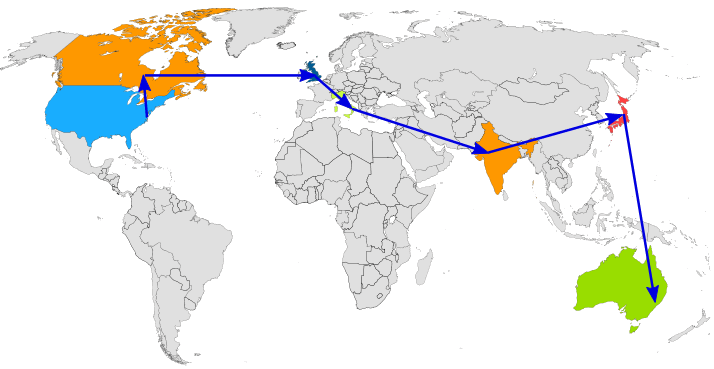Activity: Currency Conversion
In this activity, you will learn how to convert money between different currencies using an exchange rate table and a calculator.
You will need
- a calculator (or use this calculator)
- A current list of exchange rates (look up on the internet)
Vacation!
The Brown family are going to visit many different countries on their vacation.
From their home in New York they travel to Toronto (Canada), London (England), Rome (Italy), New Delhi (India), Tokyo (Japan) and Sydney (Australia), before returning home across the Pacific.
The route is shown on the following map:

Mr. Brown uses his credit card to change money from USD ($US) to the local currency in each of the locations they visit.
Because currencies change all the time, the amount of money Mr. Brown receives in each local currency will change from day to day. But the following table (old data) will give you an idea of how currencies are converted:
| Currency | Code | USD/1 unit | Units/ 1 USD |
| Australian Dollar | AUD | 0.9612 | 1.0405 |
| Canadian Dollar | CAD | 0.9788 | 1.0219 |
| Euro | EUR | 1.3065 | 0.7655 |
| British Pound | GBP | 1.5553 | 0.6431 |
| Indian Rupee | INR | 0.02174 | 46.1225 |
| Japanese Yen | JPY | 0.011916 | 83.9337 |
You will notice that there are two sets of figures for each country – the USD/ 1 unit and the Units/ 1 USD. This is because you get one rate for changing from $US to the foreign currency and a different rate for changing back from the foreign currency to the $US. This is how the banks make their money.
Note The banks also make a commission on every transaction, so they make even more money out of us! But to keep things simple we will ignore that.
So which figure should you use?
The USD/ 1 unit figure tells us how to convert one unit of the foreign currency to the US currency. The Units/ 1 USD figure tells us how to convert one unit of the US currency to the foreign currency.
Your Turn
Find today's current exchange rates! Use the internet to find them and fill them in:
| Currency | Code | USD/1 unit | Units/ 1 USD |
| Australian Dollar | AUD | ||
| Canadian Dollar | CAD | ||
| Euro | EUR | ||
| British Pound | GBP | ||
| Indian Rupee | INR | ||
| Japanese Yen | JPY |
Let's look at an example
Mr. Brown converts USD500 to Canadian dollars. How much does he receive?
We are converting to Canadian dollars, so we use the second row of the table We are converting from the US currency to the Canadian currency, so we should use the Units/ 1 USD column:
| Currency | Code | USD/1 unit | Units/ 1 USD |
| Australian Dollar | AUD | 0.9612 | 1.0405 |
| Canadian Dollar | CAD | 0.9788 | 1.0219 |
| Euro | EUR | 1.3065 | 0.7655 |
| British Pound | GBP | 1.5553 | 0.6431 |
| Indian Rupee | INR | 0.02174 | 46.1225 |
| Japanese Yen | JPY | 0.011916 | 83.9337 |
So he receives USD500 × 1.0219 = CAD510.95
Your Turn
How much will Mr. Brown receive if he changes
- USD1000 to British pounds?
- USD650 to Euro?
- USD400 to Indian Rupees?
Another example
When the Brown family arrives back in the US from Australia, Mr. Brown finds that he has AUD220 left over and wants to change it back into USD. How much does he receive?
We are converting from Australian dollars, so we use the first row of the table We are converting from the Australian currency to the US currency, so we should use the USD/ 1 unit column:
| Currency | Code | USD/1 unit | Units/ 1 USD |
| Australian Dollar | AUD | 0.9612 | 1.0405 |
| Canadian Dollar | CAD | 0.9788 | 1.0219 |
| Euro | EUR | 1.3065 | 0.7655 |
| British Pound | GBP | 1.5553 | 0.6431 |
| Indian Rupee | INR | 0.02174 | 46.1225 |
| Japanese Yen | JPY | 0.011916 | 83.9337 |
So he receives AUD220 × 0.9612 = USD211.46
Your Turn
Mr. Brown also has some other money left over. How much will he receive in USD for:
- 2,000 Yen?
- 3,500 Indian Rupees?
- 70 Euro?
